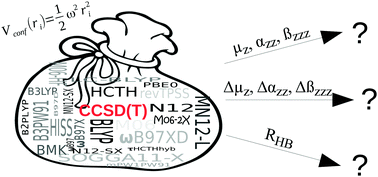DFT and spatial confinement: a benchmark study on the structural and electrical properties of hydrogen bonded complexes†
Abstract
An extended set of 37 exchange correlation functionals, representing different DFT approximations, has been evaluated on a difficult playground represented by the dipole moment (μz), polarizability (αzz), first hyperpolarizability (βzzz), and the corresponding interaction-induced electrical properties (Δμz, Δαzz, Δβzzz) of spatially confined hydrogen bonded (HB) dimers. A two-dimensional harmonic oscillator potential was used to exert the effect of spatial restriction. The performance of DFT methods in predicting hydrogen bond lengths in the studied molecular complexes upon confinement has also been examined. The data determined using a high-level CCSD(T) method serve as a reference. The conducted analyses allow us to conclude that methods rooted in DFT constitute a precise tool for the calculation of μz and αzz as well as Δμz and Δαzz, as most of the tested functionals provide results affected by rather small relative errors. On the other hand, an accurate description of the nonlinear optical response of the studied HB systems remains a great challenge for most of the analyzed DFT functionals, both in vacuum and in the presence of an analytical confining potential. Some of the tested DFT methods are found to be prone to catastrophic failure in the prediction of βzzz as well as Δβzzz. The obtained results indicate that there is no great chasm in performance between functionals belonging to different DFT approximations or functionals including different amount of Hartree–Fock exchange when the values of dipole moment and first hyperpolarizability as well as the corresponding interaction-induced electrical properties are considered. However, a higher fraction of Hartree–Fock exchange improves the quality of predictions of αzz and Δαzz. Additionally, it has been shown that only three functionals from the examined set, namely B2PLYP, B3LYP and ωB97X-D, provide highly accurate structural parameters for the investigated systems. Of significant importance is the conclusion that the ωB97X-D functional, representing a modern and highly parametrized range-separated hybrid, demonstrates the most coherent behavior, showing rather small deviations from the reference data in the case of μz, αzz, Δμz and Δαzz as well as the structural parameters of the studied HB dimers. Moreover, our results indicate that the presence of spatial confinement has a rather small effect on the performance of DFT methods.



 Please wait while we load your content...
Please wait while we load your content...